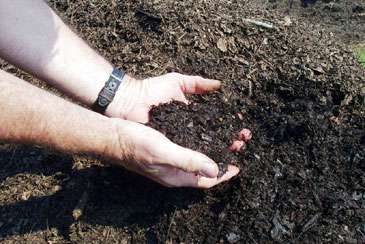Landscaping with a Green Thumb: Composting

In this article, you will find:
Nature's free gift
Landscaping with a Green Thumb: Composting
Compost is a free gift of nature that all plants thrive on. As a soil amendment or mulch, it improves the fertility and water-holding capacity of soil, encourages healthy root development in plants, and provides food for the microorganisms that help to keep soil in a balanced condition. That is exciting news for the gardener and his garden. However, maintaining a compost pile is also a wonderful favor to the environment beyond the garden walls, since it keeps kitchen and yard waste out of our overflowing landfills. Starting a compost pile is great way to manage your household waste and create a thriving, earth-friendly garden for your family.
Over the years, composting has been honed to a science, with complicated instructions about the types and ratios of materials to use, how to layer them, how to achieve the best temperature in the pile, how to speed up the process, and lots more. You can spend a great deal of money purchasing an efficient, animal-proof compost system, a special thermometer, a tool for aerating the pile, compost starter, and many other products. But the truth is, there is no mystery to composting, and it doesn't have to cost you. "Passive" composting will produce wonderful compost—it just takes longer than "managed" composting. Let's cover the basics.
What Is Compost?
Compost is decomposed carbon-rich materials (such as leaves) and nitrogen materials (such as grass clippings and kitchen scraps). It results from the feeding of hundreds of different organisms, including earthworms, insects, bacteria, and fungi. Almost any organic material is suitable for a compost pile, but the best compost has a good ratio of carbon-rich materials ("browns") to nitrogen-rich materials ("greens"). The right conditions of heat, air, and moisture will speed up the composting process and also generate heat that destroys weed seeds and plant diseases.
Choosing a Site
Your compost pile should sit on bare ground, in a level area with good drainage. If it sits on concrete or asphalt it won't drain properly, nor will earthworms be able to migrate into it to do their work. In the interests of aesthetics—and to avoid upsetting your neighbors, try to find a site that isn't too visible. If you plan to put kitchen scraps in the pile, make it convenient to your back door. If you live in a cool latitude, seek a spot that is sunny as well as sheltered from cold winter winds. If you live in a warm, dry latitude, a shady location will prevent the pile from drying out too quickly.

